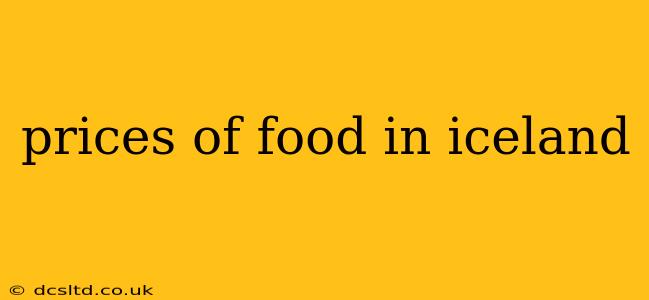Iceland, a land of fire and ice, also boasts a unique culinary scene. However, one aspect that often surprises visitors is the cost of food. This comprehensive guide delves into the factors influencing Iceland's food prices, offering insights into what to expect and how to navigate the grocery landscape.
What Factors Influence Food Prices in Iceland?
Several factors contribute to the relatively high cost of food in Iceland:
-
Geographic Location and Import Reliance: Iceland's remote location necessitates importing a significant portion of its food, leading to increased transportation costs and import duties. This impacts the price of everything from fresh produce to everyday staples.
-
Small Domestic Market: The country's small population limits economies of scale, making it more expensive to produce and distribute food locally. Smaller production volumes translate to higher unit costs.
-
Strong Icelandic Króna (ISK): While currency fluctuations can affect prices, a strong ISK generally means that imported goods become more expensive.
-
High Labor Costs: Iceland has a high minimum wage and strong labor protections, contributing to increased operational costs for businesses, including those in the food sector.
-
Value-Added Tax (VAT): Iceland's VAT adds to the final price of most goods, including food.
-
Seasonal Availability: Fresh produce is often more expensive during the colder months due to limited local production and reliance on imports.
How Expensive is Food in Iceland Really?
It's difficult to give a single definitive answer, as prices vary greatly depending on the type of food, the store, and the season. However, you can expect to pay significantly more than in many other European countries. A simple meal at a casual restaurant could cost upwards of $30-$40 USD per person, while groceries can quickly add up.
What are the prices of common groceries in Iceland?
Here's a general overview of the approximate cost of some common grocery items in Iceland (prices are approximate and can fluctuate):
- Milk (1 liter): $3-$5 USD
- Bread (loaf): $4-$6 USD
- Eggs (dozen): $5-$7 USD
- Cheese (100g): $3-$5 USD
- Meat (1kg): $20-$40 USD (depending on the cut)
- Fruits and Vegetables: Prices vary significantly depending on seasonality and origin, with imported produce being considerably more expensive. Expect to pay a premium for fresh produce, especially during winter.
Where can I find affordable groceries in Iceland?
While avoiding expensive grocery bills entirely might be challenging, there are ways to mitigate the cost:
- Discount Supermarkets: Look for larger supermarkets like Bonus, Krónan, and Nettó which generally offer lower prices than smaller stores.
- Local Farmers' Markets: Depending on the season, farmers' markets offer locally sourced produce at competitive prices.
- Cooking at Home: Eating out frequently will significantly inflate your food budget. Preparing your meals using groceries from discount supermarkets is the most cost-effective option.
- Buying in Bulk: For non-perishable items, buying in bulk can often save money.
Are there any cheaper eating options in Iceland?
Yes, while fine dining is expensive, you can still find affordable food options:
- Street Food: Look for street food stalls offering hot dogs, soup, or other quick bites, which are usually much cheaper than restaurant meals.
- Cafés: Some cafés offer reasonably priced sandwiches or light meals.
- Supermarket Prepared Meals: Many supermarkets offer pre-made meals or ready-to-heat options, which are usually a more affordable alternative to restaurant dining.
How can I budget for food in Iceland?
Planning your food budget in advance is crucial. Consider allocating a higher percentage of your travel budget to food than you would in other destinations. Tracking your spending using an app or spreadsheet can help you stay on track.
What are some tips for saving money on food in Iceland?
- Pack some non-perishable items: Bringing snacks, like granola bars or nuts, from home can help supplement your meals and reduce reliance on expensive on-the-go options.
- Take advantage of free breakfast: If your accommodation includes breakfast, make the most of it.
- Look for deals and specials: Many supermarkets offer daily specials or discounts on certain items.
- Happy hour deals: Some restaurants offer discounted drinks and food during happy hour.
This guide provides a comprehensive overview of food prices in Iceland. Remember that prices are subject to change, so it's always advisable to check current prices before your trip. By planning ahead and utilizing smart strategies, you can manage your food budget and still enjoy Iceland's unique culinary experiences.
